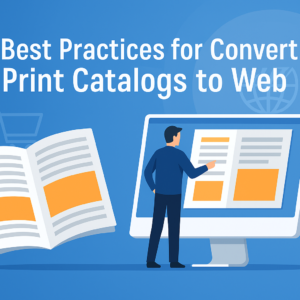
For publishers and marketers, the leap from print catalogs to engaging online experiences can feel daunting—but it’s also a huge opportunity. At 3D Issue, we live and breathe digital publishing, and we’re passionate about helping content creators unlock the full potential of their catalogs on the web. Below, we’ll explore five essential best practices that we’ve seen make a transformative difference for turning static print catalogs into immersive, responsive web experiences your audience will love.
1. Rethink for Responsive, Mobile-First Design
One of the biggest shifts when moving from print to web is realizing that your audience will access your catalog on all sorts of devices—smartphones, tablets, laptops, and desktops. A single PDF simply doesn’t cut it anymore. Web-savvy readers expect experiences that adapt to their screens, flow beautifully, and feel effortless to navigate.
- Design for all screens: Start with a mobile-first mindset. Break long text into digestible blocks, use large, readable fonts, and make generous use of whitespace.
- Flexible page layouts: Use dynamic, modular templates that automatically adjust for different screen sizes. Our Experios platform is built specifically for this, letting you design once and publish everywhere.
- Test, test, test: Preview your digital catalog on an array of devices and browsers to catch layout issues and ensure a consistent, premium experience for every reader.
2. Enhance Content with Interactive Features
Printed catalogs are inherently static, but your online version can come alive with interactivity and multimedia that deepen engagement and drive action. Think beyond flipping pages—build an experience your readers can’t help but explore.
- Rich media magic: Add video demos, audio guides, clickable image galleries, and even simple animations to draw the eye and explain features more visually.
- Interactive product hotspots: Make items shoppable by adding clickable areas or links that jump directly to product pages or e-commerce checkout. This transforms your catalog from a browsing tool into a direct driver of sales.
- Dynamic forms and calls to action: Embed lead capture forms, sign-up widgets, or request demo buttons right within your publication—perfect for B2B or high-value product catalogs.
Our Flipbooks solution is packed with options for layering in multimedia and hotspots, and makes it easy to update features as your needs evolve.
3. Structure Content for Seamless Web Navigation
Print flows in a linear way; digital is non-linear. Your readers expect multiple paths to information and intuitive navigation that respects their time.
- Table of Contents 2.0: Build a clickable, persistent menu or sidebar for easy jumping between sections, brands, or product categories. No more endless scrolling.
- Robust search: Let readers type and instantly find the exact product or detail they seek—this is especially important for larger catalogs.
- Bookmarks and notes: Empower users to mark favorites or add notes for themselves, bridging the personal touch of print with the convenience of digital.
- Fast page loads with smart previews: Make sure users aren’t stuck waiting for heavy visuals to load. Split your catalog into logical sections or use lazy loading to keep navigation brisk.
4. Prioritize Accessibility and Compliance
Web accessibility isn’t just a nice-to-have—it’s essential for reaching your full audience and meeting legal requirements. Print catalogs were limited in accessibility, but your digital edition can and should be usable by all.
- Commit to accessibility standards: Follow WCAG and ADA best practices for colors, contrast, text size, and navigation. This includes alt text for images, keyboard navigability, and skip links for readers using assistive tools.
- Validate and test: Use built-in validation tools (like those in Experios) to audit the accessibility status of your content every step of the way.
- Style options for all: Offer adjustable fonts, color schemes, and focus highlights to help users customize the interface for their needs.
Accessibility isn’t simply ticking a box—it’s about expanding your reach and demonstrating inclusivity, which pays off in reader loyalty and brand perception.
5. Leverage Analytics to Refine and Elevate
Your print catalog could only guess at what content mattered most. On the web, data becomes your most powerful feedback tool. The best publishers use these insights to evolve their catalogs and boost their ROI over time.
- Track reader engagement: See which pages are most viewed, where readers linger or drop off, and what media gets clicked. Our solutions offer built-in dashboards plus Google Analytics integrations for deeper dives.
- Iterate with confidence: Use this feedback to tweak layouts, rearrange or feature your bestselling products, and highlight seasonal trends.
- Lead capture and conversion tracking: Monitor clicks on shoppable hotspots, sign-ups from embedded forms, and even tie catalog usage back to sales or inquiries to quantify your results.
- Sustainability impact: Digital catalogs also cut out printing, mailing, and distribution waste. Share your eco-friendliness story with readers who increasingly value sustainability.
Bonus: Save Time, Reduce Costs, and Future-Proof Your Catalogs
The move to digital isn’t just about a sleeker presentation—it’s about empowering your editorial and marketing teams to work smarter. By using codeless, template-based platforms like Experios, you eliminate the need for constant developer assistance, drastically reduce production costs, and can update or refresh content in real-time rather than waiting weeks for the next print run. Secure self-hosting, seamless SEO tools, and rapid lead iteration cycles ensure your catalogs stay relevant and competitive.
Ready to Experience the Difference?
These best practices have guided countless publishers in making the transition from traditional print to high-performance digital catalogs. If you’re ready to unlock stunning, responsive, and interactive catalog experiences that delight your readers—and make your job easier—explore our full suite of digital publishing tools at 3D Issue. Or, jump straight into a free trial of Experios or Flipbooks to see what’s possible. We’d love to help you make your next digital catalog your best ever.







